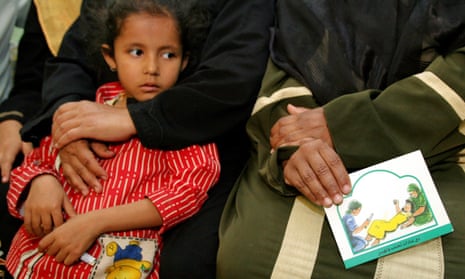Egypt has announced an ambitious plan to reduce female genital mutilation by 10-15% over the next five years by mobilising doctors and judges against a practice that still affects more than 90% of women in the country.
The national FGM abandonment strategy, announced in the ballroom of the Grand Nile Tower hotel in Cairo on Sunday, calls for doctors to be trained, prosecutors to be mobilised, and a media campaign to be launched to change public perceptions.
The scheme also urges the implementation of Egypt’s existing laws on FGM. The practice has been illegal in the country since 2008, yet there has been only one successful prosecution under that law.
The list of institutions involved in the plan is formidable: the ministries of justice, health, and education, the prestigious Sunni Islam seat of learning Al-Azhar, Egyptian church officials, and the public prosecutor’s’ office.
Yet some activists fear the campaign will fall short in eradicating FGM, and even the officials behind the new programme acknowledge they face a formidable task. The practice, which often involves the removal of the clitoris, remains prevalent in Egypt due to social and cultural pressures, which experts say are ultimately designed to control women’s bodies and sexuality.
In 2014, 92.3% of women aged 15 to 49 who have been married were subject to some form of FGM, according to government statistics contained in the launch documentation.
That figure is down from 95.8% in 2005. The vast majority of mutilations are performed by doctors and other medical professionals.
“Now we have the political support we need,” said Vivian Fouad, an official with the National Population Council, which is spearheading the anti-FGM campaign. “It’s not just a project – two years or three years and people will be convinced FGM is bad.
“It needs sustainable work, from government, from NGOs, from institutions,” she added, noting that FGM had existed in Egypt “for thousands of years”.
At the conference announcing the plan, which was attended by officials from the EU and UN, both of which are participating in the initiative, bright orange buttons were distributed bearing the words: “Enough FGM.”A video was shown as an example of the media campaign that will accompany the programme. It showed a young girl being taken to a dimly lit medical facility by her father. Once inside, she screams: “You told me we were getting a doll! Why are you bringing me here?” The father has a change of heart, returning the girl safely home.
“You were right,” he tells a woman who appears to be his wife. “I couldn’t do this to my daughter.” Elsewhere in the video, a narrator intones: “Even the prophet did not circumcise his daughters.”
Aggressive as the government initiative may be, activists say it is emblematic of a state-centered approach that will face obstacles, particularly in reaching the rural districts where FGM is most prevalent.
Reda al-Danbouki, the lawyer who was this year involved in the first successful prosecution of an FGM-related case in Egypt, is among the sceptics.
“They’re looking for a media show but not working seriously. It’s only in Cairo and Giza. I think it’s just words, not serious work,” said Danbouki, who pressed for the prosecution of a doctor after a 12-year-old girl died following her mutilation in Agga, in the Nile delta north of Cairo. “They’re not working in the villages.”
Implementation of Egypt’s existing law banning FGM is one of the most intriguing aspects of the new plan. Egypt’s judiciary is a vast and capricious institution that has emerged in recent years as a key ally of the military-backed government in pursuing an abusive clampdown on political opposition.
A glossy 43-page document detailing the anti-FGM campaign notes that “effectiveness of the judicial system is key”.
But Fouad expressed confidence about the role of prosecutors, saying at least 1,000 had already been trained in connection with anti-FGM policies.
Dalia Abd El-Hameed, head of the gender programme at the Egyptian Initiative for Personal Rights, said the campaign represented “a top-down approach to dealing with the issue of circumcision, which is extremely problematic”.
“That’s emphasising laws over change in perceptions, and in the changing of perception, prioritising religion over other aspects, like gender stereotypes,” she said.
“There is no rights-based approach in this strategy, which is very disappointing. There is no emphasis on women’s rights to bodily integrity, to be free from violence, to sexual pleasure.”
Soraya Bahgat, a women’s rights advocate, said the plan did not do enough to involve nongovernmental and grassroots groups.
“There are barriers to entry to people who want to support these great efforts, and they’re not being acknowledged here. That’s my biggest frustration,” she said.
“We’re being told that we’re welcome and thank you and everything, but the reality on the ground is if I go and tell them, ‘I need to get this done’ – with the paperwork and everything – I’m facing red tape. Especially in this time when NGOs are becoming a very bad word.”
